Imbalance in Th cell polarization and its relevance in type 1 diabetes mellitus
- PMID: 17491692
- PMCID: PMC1783566
- DOI: 10.1900/RDS.2005.2.182
Imbalance in Th cell polarization and its relevance in type 1 diabetes mellitus
Abstract
Functional polarization of T helper (Th) subsets of lymphocytes has been implicated in promoting or conferring risk to Type 1 diabetes mellitus (T1DM) development in human and diabetic animal models. It is assumed that an immoderate preponderance of type 1 immunity establishes the prerequisite for this development. Over the past years, various immune-intervention strategies have been tested to protect diabetic animals from developing overt diabetes. These protocols implicate a protective mechanism that is attributed to a change in the set of autoreactive Th cells from their Th1 to the Th2 phenotype. The studies were aimed at improving the effectiveness of Th2 cells to secrete the principal cytokines, IL-4 and IL-10, in order to mediate protection from diabetes in NOD mice. In contrast, some immune-modulation protocols utilizing non-specific reagents report that diabetes protection is apparently attributed to preferential survival of both Th1 and Th2 cells, rather than via a shift from their Th1 to Th2 phenotypes. Even though we know that excessive immune responses against self antigens are also controlled and terminated by regulatory T cells, this article focuses on the polarization of Th effector cells and discusses the controversial findings regarding the Th1/Th2 hypothesis to draw a conclusion on its relevance in T1DM from the existing knowledge.
Figures

Similar articles
-
The concept of type-1 and type-2 helper T cells and their cytokines in humans.Int Rev Immunol. 1998;16(3-4):427-55. doi: 10.3109/08830189809043004. Int Rev Immunol. 1998. PMID: 9505198 Review.
-
Type 1 T helper and type 2 T helper cells: functions, regulation and role in protection and disease.Int J Clin Lab Res. 1991;21(2):152-8. doi: 10.1007/BF02591635. Int J Clin Lab Res. 1991. PMID: 1687725 Review.
-
T-cell regulation in murine and human autoimmune diabetes: the role of TH1 and TH2 cells.Diabetes Metab. 1997 Nov;23(5):377-85. Diabetes Metab. 1997. PMID: 9416429 Review.
-
Modulation of immune cells and Th1/Th2 cytokines in insulin-treated type 2 diabetes mellitus.Afr Health Sci. 2016 Sep;16(3):712-724. doi: 10.4314/ahs.v16i3.11. Afr Health Sci. 2016. PMID: 27917204 Free PMC article.
-
Role of antigen-presenting cells in the polarized development of helper T cell subsets: evidence for differential cytokine production by Th0 cells in response to antigen presentation by B cells and macrophages.Eur J Immunol. 1994 Oct;24(10):2506-14. doi: 10.1002/eji.1830241037. Eur J Immunol. 1994. PMID: 7925578
Cited by
-
Chemokine (C-C motif) ligand 2 (CCL2) in sera of patients with type 1 diabetes and diabetic complications.PLoS One. 2011 Apr 12;6(4):e17822. doi: 10.1371/journal.pone.0017822. PLoS One. 2011. PMID: 21532752 Free PMC article.
-
Immunological Aspects of Fulminant Type 1 Diabetes in Chinese.J Immunol Res. 2016;2016:1858202. doi: 10.1155/2016/1858202. Epub 2016 Feb 14. J Immunol Res. 2016. PMID: 26981545 Free PMC article.
-
Genetic deficiency of Itgb2 or ItgaL prevents autoimmune diabetes through distinctly different mechanisms in NOD/LtJ mice.Diabetes. 2009 Jun;58(6):1292-301. doi: 10.2337/db08-0804. Epub 2009 Feb 17. Diabetes. 2009. PMID: 19223596 Free PMC article.
-
Novel biomarkers in type 1 diabetes.Rev Diabet Stud. 2012 Winter;9(4):224-35. doi: 10.1900/RDS.2012.9.224. Epub 2012 Dec 28. Rev Diabet Stud. 2012. PMID: 23804262 Free PMC article. Review.
-
Vitamin D Deficiency as a Possible Cause of Type 1 Diabetes in Children and Adolescents up to 15 Years Old: A Systematic Review.Rev Diabet Stud. 2022 Jun 30;18(2):58-67. doi: 10.1900/RDS.2022.18.58. Rev Diabet Stud. 2022. PMID: 35831940 Free PMC article.
References
-
- Mossman TR, Cherwinski H, Bond MW, Giedlin MA, Coffman RL. Two types of murine helper T cell clone. 1. Definition according to profiles of lymphokine activities and secreted proteins. J Immunol. 1986;136:2348–2357. - PubMed
-
- Mosmann TR, Sad S. The expanding universe of T-cell subsets: Th1, Th2 and more. Immunol Today. 1996;17:138–146. - PubMed
-
- Romagnani S. Lymphokine production by human T cells in disease states. Ann Rev Immunol. 1994;12:227–257. - PubMed
-
- Nakamura T, Kamogawa Y, Bottomly K, Flavell RA. Polarization of IL-4- and IFN-gamma-producing CD4+ T cells following activation of naive CD4+ T cells. J Immunol. 1997;158:1085–1094. - PubMed
LinkOut - more resources
Full Text Sources
Miscellaneous
